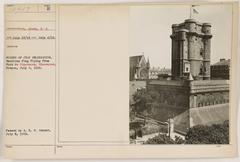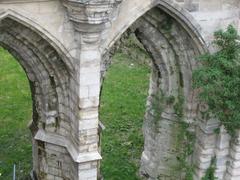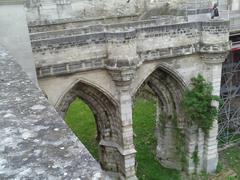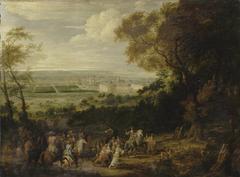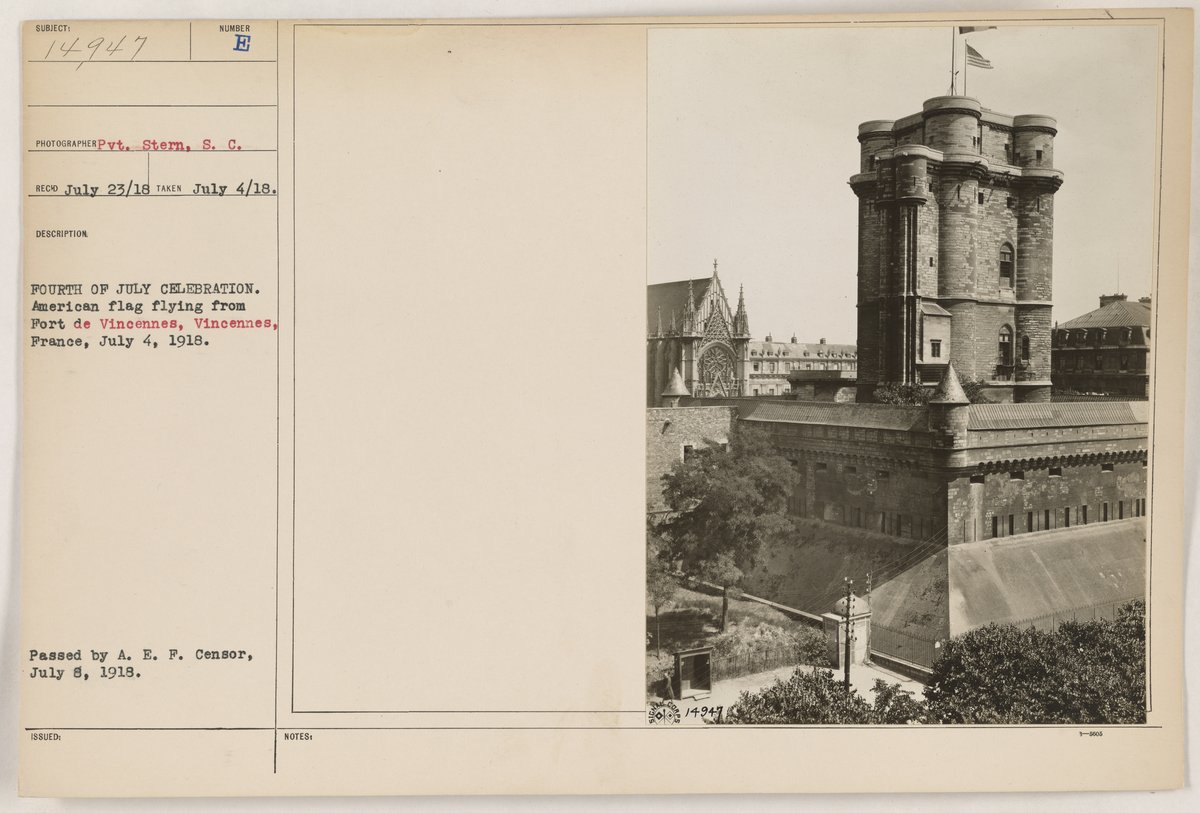
Château de Vincennes: Visiting Hours, Tickets, and Paris Historical Sites Guide
Date: 14/06/2025
Introduction: A Medieval Gem at Paris’s Eastern Edge
The Château de Vincennes, rising majestically just east of central Paris, is one of France’s most impressive and best-preserved medieval fortresses. Rich in royal history, architectural grandeur, and cultural significance, it offers an immersive journey spanning over eight centuries—from its origins as a 12th-century hunting lodge for King Louis VII to its role as a royal residence, state prison, military stronghold, and, today, a vital heritage site open to the public (Paris Pass; TripSavvy).
With its iconic 52-meter donjon—the tallest medieval fortified structure in Europe—elegant Sainte-Chapelle, and beautifully restored ramparts, the château stands as a testament to evolving French monarchy, architectural innovation, and national memory. This guide offers comprehensive, up-to-date information on visiting hours, ticketing, accessibility, major attractions, and nearby sights, helping you make the most of your visit to one of Paris’s most remarkable historical sites (Google Arts & Culture; SoloSophie; Official Site; France Today; The Better Vacation).
Table of Contents
- History and Cultural Significance
- Architecture and Major Highlights
- Visiting Hours and Ticket Information
- Accessibility and Getting There
- Touring the Château: What to See
- Visitor Amenities and Practical Tips
- Events and Special Activities
- Nearby Attractions
- Frequently Asked Questions (FAQ)
- Conclusion and Call to Action
- References
History and Cultural Significance
Origins and Royal Power
The Château de Vincennes began as a 12th-century hunting retreat for King Louis VII. Over the next centuries, it evolved into a vital hub for Capetian and later Valois monarchs, offering a secure sanctuary close to the capital. By the 14th century, under Philip VI and Charles V, Vincennes was transformed into a mighty fortress. Its monumental donjon became the tallest in Europe, symbolizing royal authority and advanced military design (Live the World; Places in France).
Renaissance, Decline, and Transformation
During the Renaissance, the château gained elegant classical pavilions designed by Louis Le Vau, reflecting shifting tastes from medieval fortification to baroque splendor. However, the royal court’s move to Versailles in 1682 marked Vincennes’ decline as a royal residence. By the late 18th century, it was repurposed as a porcelain factory, then as a state prison, housing notable figures such as the Marquis de Sade and Denis Diderot (Paris Pass; Google Arts & Culture).
Modern Era and Preservation
The château’s military role continued through the Napoleonic Wars, Restoration, and both World Wars. It saw tragic events such as the execution of the Duc d’Enghien in its moat and Mata Hari during World War I. Damaged during WWII, it underwent extensive restoration, culminating in the reopening of the donjon in 2007 and Sainte-Chapelle in 2009 (Live the World). Today, the site is managed by the Centre des Monuments Nationaux and stands as a symbol of France’s enduring heritage (France Today).
Architecture and Major Highlights
The Donjon (Keep)
The 14th-century donjon is a marvel of medieval military architecture. Standing 52 meters tall, it was both a formidable defensive structure and a royal residence, with walls up to 3 meters thick. Spiral staircases lead through six floors: from ground-level cellars and storerooms to the king’s apartments, council chambers, and rooftop views of Paris and the Bois de Vincennes (SoloSophie; France Voyage).
Sainte-Chapelle de Vincennes
Founded in 1379 and completed in the 16th century, this Gothic chapel was inspired by the famous Sainte-Chapelle on Île de la Cité. Its single nave, soaring vaults, and stunning stained glass windows were designed to house holy relics and impress the royal court. Restoration efforts have revived its luminous beauty (SoloSophie; TripSavvy).
Ramparts and Wall Walk
Visitors can walk along the curtain walls and towers, experiencing firsthand the defensive innovations that made Vincennes one of Europe’s most formidable fortresses. Panoramic views and photo opportunities abound (France Voyage).
Royal Apartments and Historical Rooms
Explore recreated chambers, council halls, and administrative rooms that once housed kings, queens, and their courts. Exhibits detail daily life, governance, and the château’s evolution over centuries (France Voyage).
Service Historique de la Défense
A must for military history enthusiasts, this archive houses hundreds of thousands of documents and artifacts. Rotating exhibitions showcase France’s military past (France Voyage).
Gardens and Grounds
The château’s expansive courtyards and gardens offer a tranquil escape. Adjacent to the Bois de Vincennes, they provide ideal spots for a stroll or picnic (The Better Vacation).
Visiting Hours and Ticket Information
Opening Hours
- May 21 – September 22: Daily, 10:00 AM – 6:00 PM
- September 23 – May 20: Daily, 10:00 AM – 5:00 PM
- Last admission: 45 minutes before closing
- Sainte-Chapelle: Closes 30 minutes before the main site; may close for lunch (verify on official site)
- Closed: January 1, May 1, December 25
Ticket Prices
- Standard adult: €13 (as of June 2025)
- Reduced rates: For students, seniors, and groups
- Free entry: Under 26 (EU residents), and on the first Sunday of each month (November–March) (chateau-de-vincennes.fr)
- Passion Monuments: Annual pass for unlimited access to 80+ French monuments
- Purchase: Online (recommended) or at entrance
Accessibility and Getting There
Physical Accessibility
- Partial wheelchair access: Ground level and some exhibits; upper keep levels accessed via spiral stairs and are not accessible
- Assistance: Staff available to help; advance notice recommended for special needs (The Better Vacation)
Getting There
- Metro: Line 1, “Château de Vincennes” station (5-min walk)
- RER: Line A, “Vincennes” station (short walk)
- Bus: Lines 46, 56, 86
- Bicycle: Vélib’ stations nearby; unguarded parking available
- Car: No general parking; street parking is limited; only visitors with valid disability cards may park on-site (chateau-de-vincennes.fr; welovegreen.fr)
Touring the Château: What to See
- The Keep: Six floors of medieval architecture, royal apartments, and prison cells, plus rooftop views
- Sainte-Chapelle: Exquisite stained glass, rose window, and religious art
- Ramparts: Panoramic wall walks and towers
- Royal Apartments: Insight into royal life and statecraft
- Historical Exhibits: Military archives, exhibitions, and prisoner graffiti from WWII (Ibarra Real)
- Gardens: Peaceful lawns and access to the Bois de Vincennes
Visitor Amenities and Practical Tips
- Guided Tours: Free guided tours (in French) at 10:30 AM and 2:30 PM, plus Revelacio multimedia tablets in English, French, and Spanish (ID deposit required) (chateau-de-vincennes.fr)
- Restrooms: Available on site
- Cloakroom: None—travel light
- Family Visits: Special tours for ages 6–15; group and school visits by arrangement
- Food: No restaurants on site; plenty of cafés and eateries in Vincennes town. Picnics welcome in adjacent parks (paristouristinformation.fr)
- Security: Vigipirate plan (bag checks, no large luggage)
- Photography: Allowed except in restricted areas; respect guidelines
Events and Special Activities
Château de Vincennes hosts a range of events, including concerts, historical reenactments, sports tournaments, and special exhibitions. Check the official website for up-to-date programs.
Nearby Attractions
- Bois de Vincennes: Paris’s largest park, ideal for walking, cycling, and boating
- Parc Floral: Beautiful gardens and seasonal events
- Vincennes Zoo: Family-friendly animal park nearby
- Louis Lumière Museum: Cinema history
- Easy Metro access: Combine with Notre-Dame, the Louvre, and other Paris landmarks
Frequently Asked Questions (FAQ)
Q: What are the visiting hours?
A: Open daily (except Jan 1, May 1, Dec 25). May–Sept: 10:00–18:00; Sept–May: 10:00–17:00. Last entry 45 minutes before closing.
Q: How much are tickets?
A: Standard adult €13; reduced rates and free entry for eligible visitors. See official site for details.
Q: Is the château accessible?
A: Partially accessible; ground level available for wheelchairs. The upper keep is not accessible due to stairs.
Q: Are guided tours available?
A: Yes, free French tours and multimedia tablets in multiple languages; check schedules online.
Q: Can I take photos?
A: Yes, except in restricted areas; observe posted guidelines.
Q: Is it suitable for children?
A: Yes, with family tours and educational programs.
Q: Are there free admission days?
A: Yes, first Sunday Nov–March.
Conclusion and Call to Action
The Château de Vincennes is a must-see for anyone interested in Paris’s history, medieval architecture, and royal heritage. With its towering donjon, exquisite chapel, and peaceful gardens, it offers a captivating and accessible destination for visitors of all ages. Plan your visit by checking the latest hours and ticket options on the official website. For audio guides, tour enhancements, and exclusive tips, download the Audiala app and follow us on social media.
References
- Château de Vincennes: Visiting Hours, Tickets, and Guide to Paris Historical Sites, Live the World
- Paris Pass
- Places in France: Château de Vincennes Guide
- Google Arts & Culture
- France Today: Discover the Secrets of the Château de Vincennes
- The Better Vacation: Visitor Information
- Official Site: Practical Information
- France Voyage: Tourism Guide
- Ibarra Real: Historical Secrets
- World in Paris: Visitor Tips
- Paris Insider’s Guide
- City Unscripted: Visit Overview
- SoloSophie
- TripSavvy
- welovegreen.fr
- paristouristinformation.fr
